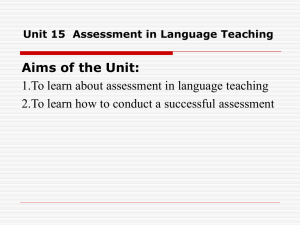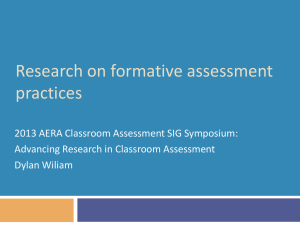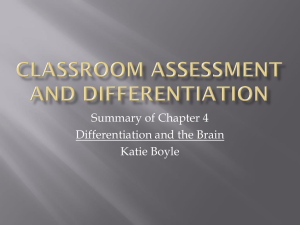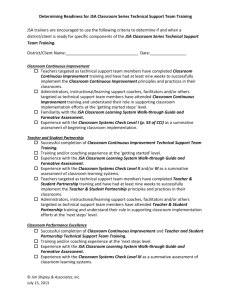ou-lesson 2 - CLSU Open University
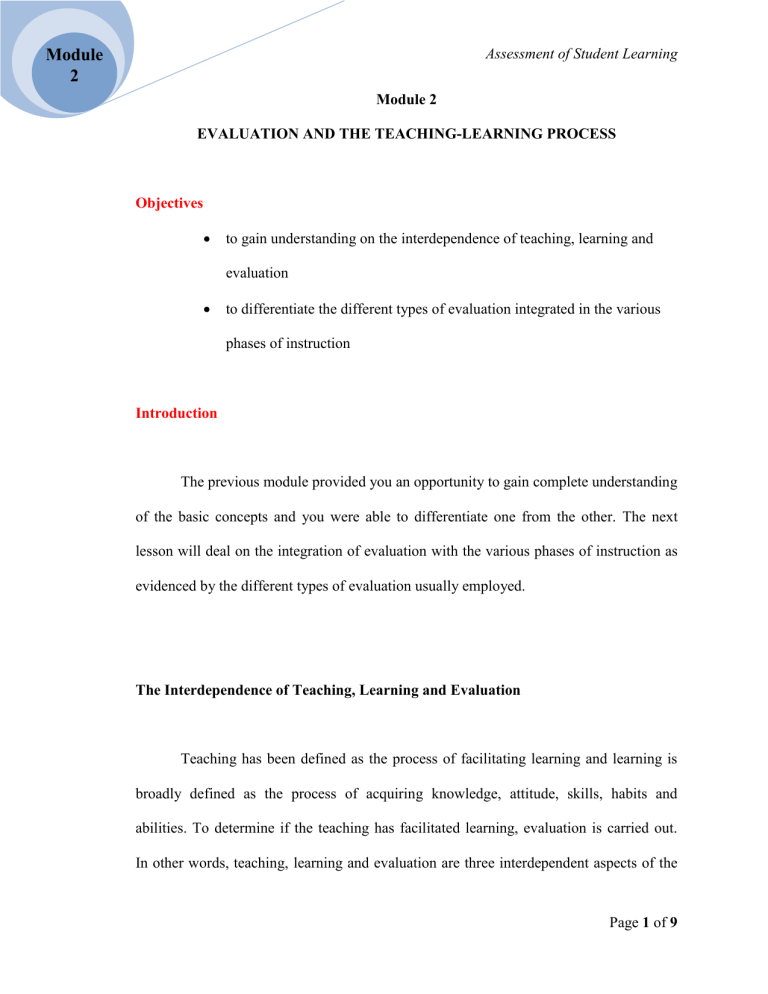
Module
2
Assessment of Student Learning
Module 2
EVALUATION AND THE TEACHING-LEARNING PROCESS
Objectives
to gain understanding on the interdependence of teaching, learning and evaluation
to differentiate the different types of evaluation integrated in the various phases of instruction
Introduction
The previous module provided you an opportunity to gain complete understanding of the basic concepts and you were able to differentiate one from the other. The next lesson will deal on the integration of evaluation with the various phases of instruction as evidenced by the different types of evaluation usually employed.
The Interdependence of Teaching, Learning and Evaluation
Teaching has been defined as the process of facilitating learning and learning is broadly defined as the process of acquiring knowledge, attitude, skills, habits and abilities. To determine if the teaching has facilitated learning, evaluation is carried out.
In other words, teaching, learning and evaluation are three interdependent aspects of the
Page 1 of 9
Module
2
Assessment of Student Learning educative process (Grondlund, 1981). This interdependence is clearly seen when the main purpose of instruction is conceived in terms of helping students achieve a set of learning outcomes which include changes in the cognitive, psychomotor and affective domains. Simply put, the instructional objectives or the desired changes in the students
(learning) are brought about by planned learning activities (teaching), and the students’ progress is determined by tests and other devices (evaluation).
The integration of evaluation (always remember that measurement and assessment are always part of it) into the teaching –learning process can be seen in the following stages of the process:
1.
In setting instructional objectives
Both teaching and evaluations start with the determination of objectives.
These objectives are stated in terms of desirable student behavior in the three general domains of learning: cognitive (i.e. knowledge), affective (i.e. attitude) and psychomotor (i.e. skills). It is these objectives that provide direction to teaching. They aid the teachers in making decisions regarding the types of methods, activities and materials he has to provide. To be most useful, these objectives must be attainable, observable and measurable. If for example, the teacher’s instructional objective is for the students to “ draw and label the parts of a gumamela flower
”, this outcome will determine his methods, his materials and the kinds of tests he will be giving at the end of instruction.
Page 2 of 9
Module
2
Assessment of Student Learning
2.
In determining student variables that can affect instruction
Prior to instruction, it is generally desirable for teachers to carry out preassessment to determine students’ background abilities, experiences and interests in relation to learning outcomes. This process provides information which the teacher can use in making instructional plans, and remedial works to meet students’ needs. While some students already have the prerequisite skills in learning the new lesson, evaluation will help the teacher determine the degree of background information the students have in their repertoire.
3.
In providing instructional activities that are relevant and necessary to achieve the desired learning outcomes.
During this sate, lessons or subject matter and the procedures of teaching are integrated into the learning activities which are designed to help students achieve the desired learning outcomes. At this stage, evaluation provides the teacher and the students with the necessary feedback or information regarding students’ progress and difficulties. This feedback is very useful in helping teachers make adjustments in the various instructional procedures.
4.
In determining the extent to which desired learning outcomes are achieved.
To determine the extent to which desired learning outcomes are achieved, various types of tests and evaluative instruments are used. Evaluation of learning outcomes provides the students with information regarding the nature of the
Page 3 of 9
Module
2
Assessment of Student Learning learning outcomes, his progress toward attaining these outcomes as well as his difficulties in moving towards them. On the other hand, the teacher gains information regarding the appropriateness of the instructional objectives, and the effectiveness of his teaching methods and materials. Therefore, evaluation improves both the teaching and learning process.
In the various phases of instruction, evaluation is integrated. The type of evaluation is determined by the phase of instruction it is employed. The four types of evaluation are placement, formative, diagnostic and summative.
Placement evaluation
This type of evaluation accounts for a student’s entry behavior or performance. It determines the knowledge and skills the students possesses which are necessary at the beginning of instruction in a given subject area. If for example, evaluation reveals that a number of students in the class who is about to study mathematical operations do not have mastery of number concepts, it will be difficult for such students to learn the desired outcome because they do not have the prerequisite skills. Likewise, evaluation shows the extent to which students have already mastered the objectives of the area to be studied. In either case, the teacher is guided as to what activities he will be providing for the students who do not have the needed skills and for the students who already have mastery of the lesson. Aptitude tests, readiness tests, inventories and observations are forms of placement evaluation.
Page 4 of 9
Module
2
Assessment of Student Learning
Formative evaluation
Formative evaluation provides the student with feedback regarding his success or failure in attaining the instructional objectives. It also identifies the specific learning error that needs to be corrected. For instance, a student learn that he score high on the objective part of the test but failed to get a passing score for the essay part, he is reinforced to exert more effort in answering essay questions in the succeeding tests. On the part of the teacher, formative evaluation provides information for making instruction and remedial more effective. Quizzes, unit tests and chapter tests are examples of evaluative instruments used in this type of evaluation.
Diagnostic evaluation
This type of evaluation is used to detect students’ learning difficulties which are not revealed by formative tests or checked by remedial instruction and other instructional adjustments. The purpose of formative evaluation is to determine the extent to which students are accomplishing the learning targets; therefore it focuses on the measurement of the intended outcomes. It is diagnostic evaluation that discovers and explains the underlying causes of learning difficulties. Diagnostic tests are therefore more comprehensive and detailed.
Page 5 of 9
Module
2
Assessment of Student Learning
Summative evaluation
Summative evaluation determines the extent to which objectives of instruction have been achieved, and is used for assigning course grades.
Techniques for obtaining information about student achievement include oral reports, projects, term papers and teacher-made achievement tests. The results from these evaluative instruments will be assessed and results are combined.
Based on course requirement and standards, the resulting sum is then given meaning, such as to whether how good or how satisfactory the student is accomplishing the objectives of instruction
Page 6 of 9
Module
2
Assessment of Student Learning
Activity 1
Fill in the boxes with the appropriate teaching and evaluation processes.
Evaluate intended learning outcomes
Provide relevant instruction
Pre-assess students’ needs
Diagnose student’s difficulties
Monitor learning progress
Formulate instructional objectives
Simplified Instructional Model
Formative evaluation
Summative evaluation
Diagnostic evaluation
Placement evaluation
Evaluation Procedures
Page 7 of 9
Module
2
Assessment of Student Learning
Activity 2
A. Read each question very carefully. Choose the correct answer from the alternatives which follow.
1.
Which is the most acceptable statement of relationship between evaluation and teaching? a.
Teaching and evaluation are complementary and interdependent aspects of the same learning process. b.
Teaching is what counts; evaluation is but a secondary aspect of the process of child growth c.
Teaching and evaluation are relatively independent, each can exist without the other d.
Evaluation is the important thing; teaching only serves to get the child ready for evaluation of learning outcomes
2.
What is the main purpose of classroom evaluation? a.
To appraise the effectiveness of the teacher b.
To measure the extent to which objectives are realized c.
To compare the students with norms d.
To improve instruction
3.
What do diagnostic tests identify? a.
The specific nature of the remedial program b.
The general areas of weakness in class performance c.
The causes underlying academic difficulties d.
The specific nature of pupil difficulties
4.
Which is most useful in determining students’ grades? a.
Pre-tests b.
Diagnostic tests c.
Formative tests d.
Summative tests
5.
Which should be given prime consideration when conducting evaluation? a.
Objectives b.
Evaluative devices c.
Norms and standards d.
Measurement procedures
B. Discuss the similarities and differences of summative evaluation and formative evaluation differ? similar?
Page 8 of 9
Module
2
Assessment of Student Learning
Activity 3 .
Write a short reflection on lesson 2.
Page 9 of 9



